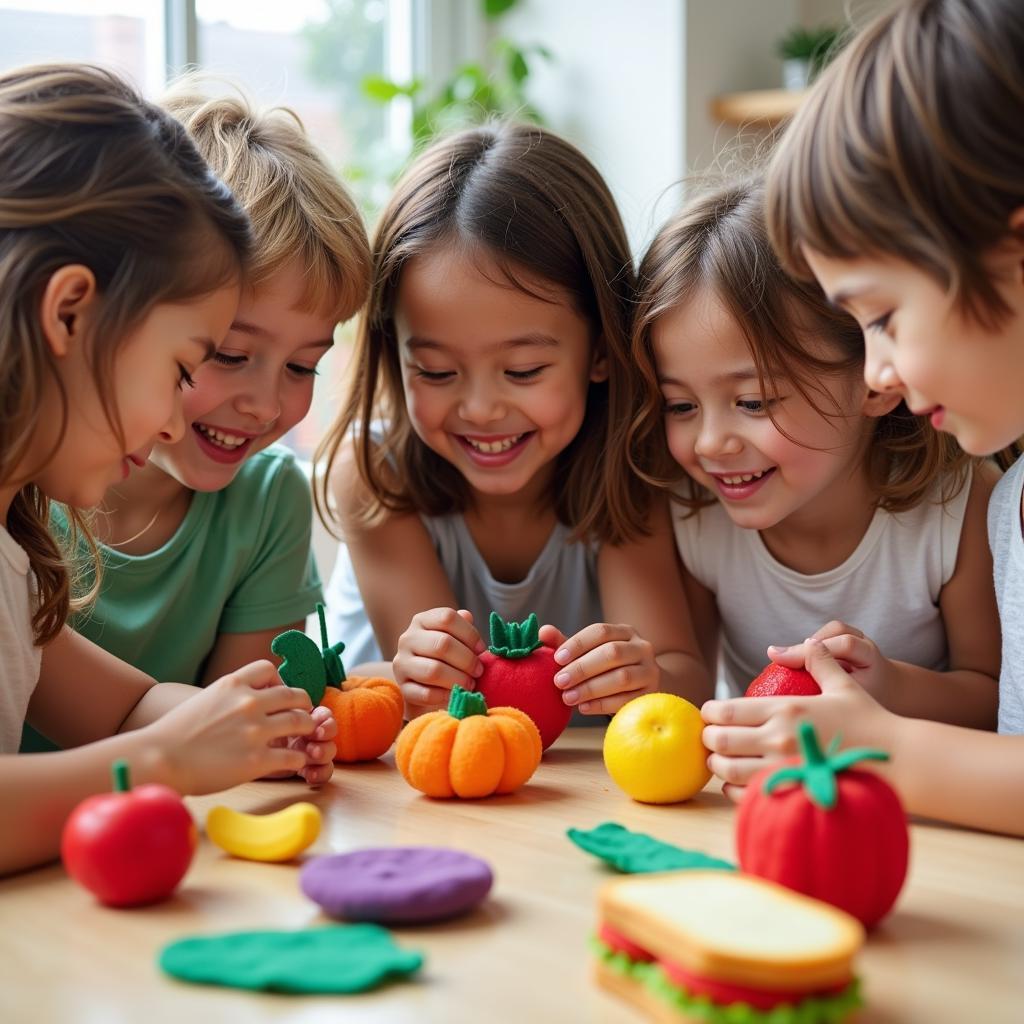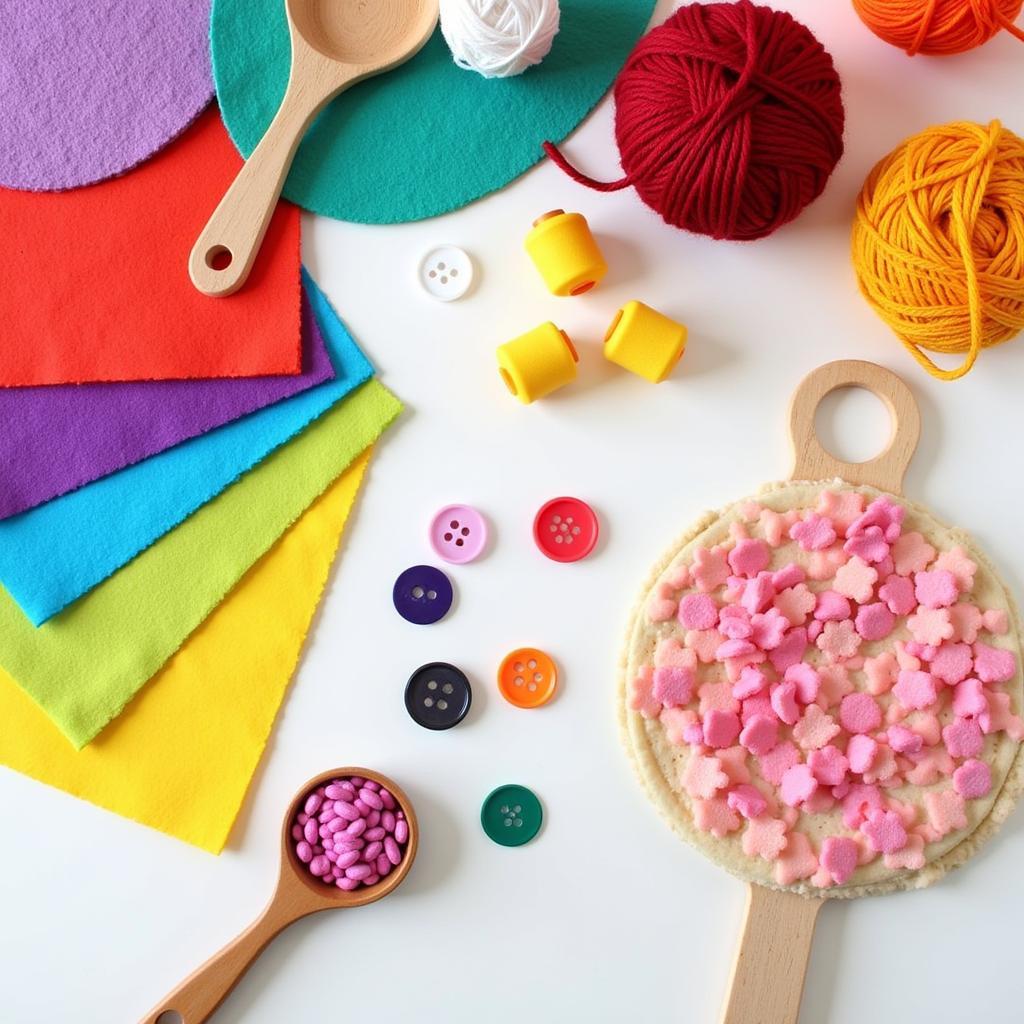Diy Play Food is more than just a craft; it’s a gateway to a world of imagination, creativity, and learning for kids of all ages. Whether you’re a parent, caregiver, or educator, crafting play food offers a unique opportunity to engage children in hands-on activities that stimulate their senses and foster essential developmental skills. From the texture of felt fruits and vegetables to the vibrant colors of play dough pizzas, DIY projects provide endless possibilities for fun and educational play.
Why Choose DIY Play Food?
 Children engaging in imaginative play with DIY felt food
Children engaging in imaginative play with DIY felt food
In a world dominated by screens, DIY play food provides a refreshing and engaging alternative for children. Unlike pre-made toys, creating play food allows kids to participate in the entire process, from choosing materials and colors to assembling the final product. This hands-on approach nurtures their creativity, problem-solving abilities, and fine motor skills.
Here are just a few compelling reasons to embrace DIY play food:
- Unlimited Creativity: Unlike store-bought options, DIY play food allows children to design and create anything their imaginations can conjure. They can experiment with different colors, textures, and shapes, fostering their artistic expression and individuality.
- Enhanced Fine Motor Skills: Cutting, gluing, sewing, and shaping play food ingredients help children develop their fine motor skills, hand-eye coordination, and dexterity. These skills are crucial for everyday tasks like writing, drawing, and dressing themselves.
- Sensory Exploration: DIY play food offers a rich sensory experience for young learners. The feel of different fabrics, the vibrant colors of paints and felt, and the act of assembling various parts stimulate their senses and contribute to their overall sensory development.
- Educational Value: Creating play food opens up a world of learning opportunities. Children can learn about different food groups, healthy eating habits, counting, sorting, and even basic cooking concepts through imaginative play.
- Social-Emotional Development: DIY play food encourages social interaction and collaboration, especially when children work together on projects. It also helps them develop language skills, emotional regulation, and problem-solving abilities through role-playing and imaginative scenarios.
Getting Started with DIY Play Food: Essential Materials
 An assortment of colorful felt, yarn, buttons, and crafting tools arranged neatly on a table.
An assortment of colorful felt, yarn, buttons, and crafting tools arranged neatly on a table.
Creating DIY play food is easier than you might think! With a few basic materials and a dash of creativity, you can transform everyday items into engaging playthings. Here’s a list of essential materials to get you started:
Basic Materials:
- Felt: Felt is a versatile and forgiving material perfect for crafting play food. It’s available in a rainbow of colors and comes in various thicknesses, making it suitable for everything from simple fruits to elaborate meals.
- Fabric Scissors: Invest in a good pair of fabric scissors to ensure clean, precise cuts. Sharp scissors will make your crafting experience more enjoyable and yield professional-looking results.
- Fabric Glue: Fabric glue is a must-have for securing felt pieces together. Choose a non-toxic, washable glue that dries clear for a lasting bond and a neat finish.
- Stuffing (Fiberfill or Cotton Balls): Stuffing adds a realistic dimension to play food items like plush fruits and vegetables. It also makes them soft and cuddly, perfect for little hands.
- Embroidery Floss: Embroidery floss adds detail and texture to play food. Use it to stitch on features like seeds, leaves, or decorative patterns.
Optional Materials:
- Buttons: Buttons in various shapes and sizes can be used to embellish play food, adding a touch of whimsy and visual interest.
- Yarn: Yarn is excellent for creating hair-like details on fruits and vegetables or for crafting pretend noodles and spaghetti.
- Fabric Markers or Pens: These are handy for adding details, writing on play food packaging, or personalizing creations.
- Velcro: Attaching velcro to play food pieces allows children to “cut” and reassemble them during play, further enhancing the interactive experience.
Easy DIY Play Food Ideas
Ready to embark on your DIY play food adventure? Here are a few easy and engaging ideas to spark your creativity:
1. Felt Food: The Basics
Felt food is incredibly versatile and perfect for beginners. Start with simple shapes like fruits, vegetables, and sandwiches. Cut two identical shapes from felt, stitch them together leaving an opening for stuffing, fill with fiberfill, and hand-stitch the opening closed.
Expert Tip: “When crafting felt food, use a disappearing ink pen to lightly draw your shapes on the felt before cutting. This ensures accuracy and makes cutting intricate designs easier.” – Emily Craft, Play Food Designer
2. Play Dough Delights
Play dough offers endless possibilities for creating imaginative meals. Provide children with various colors of play dough, cookie cutters, and small tools like plastic knives and rolling pins to shape and mold their culinary creations.
3. Fabric Scrap Treats
Don’t throw away those fabric scraps! Use them to create colorful and textured cookies, cakes, and other sweet treats. Cut out desired shapes, layer them for visual interest, and secure with fabric glue. Add decorative stitching or buttons for a finishing touch.
4. Yarn Noodles and Pasta
Yarn is perfect for making realistic-looking noodles and pasta. Simply cut yarn into desired lengths for noodles or twist and braid them for different pasta shapes. Combine with felt sauces and toppings for a complete play food experience.
Conclusion
DIY play food offers a world of benefits for children, fostering their creativity, fine motor skills, and imaginative play. From simple felt creations to elaborate play dough feasts, the possibilities are endless. Gather your materials, unleash your creativity, and embark on a journey of fun and learning with DIY play food.
Frequently Asked Questions
1. What are some safety tips for DIY play food?
Always supervise children during crafting activities. Use non-toxic materials and secure small parts like buttons tightly.
2. Can I wash DIY play food?
The washability of DIY play food depends on the materials used. Felt items can often be hand-washed with mild detergent, while play dough creations are best enjoyed as temporary masterpieces.
3. Where can I find inspiration for DIY play food projects?
Online platforms like Pinterest, Instagram, and crafting blogs offer a wealth of inspiration for DIY play food creations. You can also find numerous books and tutorials dedicated to this craft.
4. What other materials can I use for DIY play food?
Get creative! Recycle cardboard boxes, egg cartons, and other household items to create unique and eco-friendly play food.
5. How can I encourage my child to engage with DIY play food?
Join in the fun! Create your own play food alongside your child, set up a pretend restaurant or grocery store, and encourage imaginative role-playing.
Need assistance with your DIY play food adventures? Our friendly customer support team is here to help! Contact us at Phone Number: 02437655121, Email: minacones@gmail.com, or visit us at 3PGH+8R9, ĐT70A, thôn Trung, Bắc Từ Liêm, Hà Nội, Việt Nam. We are available 24/7 to assist you.